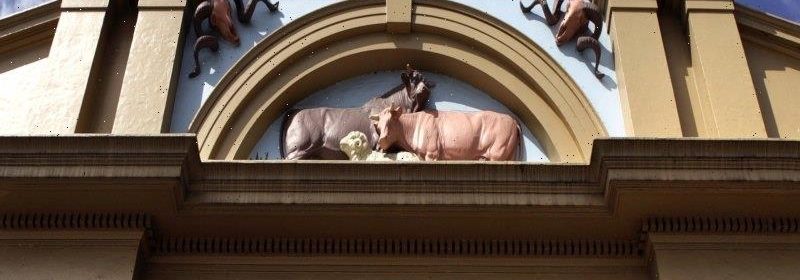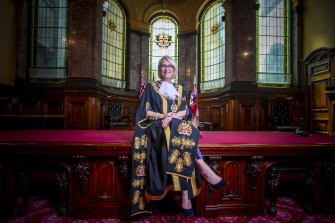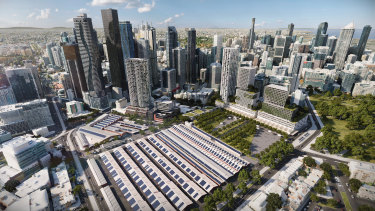Big-spending budget aims to get Melbourne out of the COVID-19 doldrums

The City of Melbourne will be more than $26 million in the red in the coming financial year, as it prepares a big-spending budget aimed at stimulating the city’s economic recovery.
Underlying the budget forecasts is an assumption the city is on the road to recovery from the effects of repeated lockdowns and COVID-19 restrictions, including a $21.5 million investment in major events, designed to bring crowds back into the CBD.
Lord mayor Sally Capp says the budget will be back in the black next financial year.Credit:Wayne Taylor
Amid rising confidence, City of Melbourne footpath sensors last month showed pedestrian activity had returned to 72 per cent of pre-pandemic levels.
But the council’s budget was handed down within minutes of renewed COVID-19 restrictions being announced, including a 30-person cap on public gatherings, and the requirement masks be worn indoors.
Lord mayor Sally Capp said the new cases were frustrating, and urged Melburnians to remain vigilant in supressing the virus.
“Well, of course everyone feels the frustration of needing to respond to recent outbreaks,” Cr Capp said.
“From our perspective this is very much about what we have been doing and shown we can do so well over the last 12 months or so. It’s listening to the health experts; importantly, it’s remaining absolutely vigilant about the measures that can help contain the spread of the virus. And the better that we can do that, the more confident we can be about the city staying open and businesses staying open.”
Modelling conducted by consulting giant PwC for the City of Melbourne last year predicted the economic effects of the pandemic on inner Melbourne would be far worse than the 1990s recession, and equivalent to the combined impacts on the city of World War I and the Spanish flu pandemic.
It forecast $110 billion could be lost over four years, and the city’s economy would contract by $23.5 billion this year.
Tuesday’s budget shows a more optimistic view of the city’s recovery, with council officers forecasting the City of Melbourne would return to surplus in 2022-23.
Aided by state government support, the council has achieved a $31.2 million turnaround since last year’s budget, which posted a $57.4 million debt.
Finance portfolio lead councillor Philip Le Liu said the council would return to surplus in the 2022-23 financial year through “prudent financial management”, including by slashing $12 million on spending on contractors, procurement and administration.
“Our decision to continue investing in our city’s recovery is deliberate because in driving a faster growing economy our own bottom line improves more rapidly and we have a clear path back to surplus.”
The council will pour $100 million into a $200 million joint fund with the Andrews government, designed to revitalise the city’s economy over the next two years, and spend $244.5 million on infrastructure, aiming to create more than 2800 jobs.
An artist’s impression of Market Square, which will be on the current site of the Queen Victoria Market car park.
Of this, $114.1 million will go on new infrastructure like footpaths and roads and $50.2 million on the Queen Victoria Market precinct.
As part of the Queen Victoria Market precinct renewal, the existing open-air car park, built over Melbourne’s first cemetery on the Franklin Street end of the market, will be transformed into 1.75 hectares of new public space, to be called Market Square.
A new car park will open in July on Queen Street, 20 metres from the fresh produce traders’ stall.
The budget also includes $11.3 million for new facilities at the market, including two new sheds with logistics, storage, waste and recycling facilities, customer toilets and trader bathrooms and meeting areas.
The council has put $1 million towards designs for its ambitious Greenline project, a four-kilometre green trail between Birrarung Marr and the Bolte Bridge.
The project is expected to cost $300 million, with the council seeking funding from the state and federal governments and the private sector.
The council budget is prioritising support for businesses, particularly in hospitality, which has been battered by the past year’s COVID-19 restrictions.
The city will absorb 75 per cent of the costs of outdoor dining , subsidising permits from July 1, and offer a 25 per cent rates discount for 3750 food businesses in the city.
Cr Capp said encouraging hospitality businesses to offer outdoor dining and cutting red tape had helped save jobs over the past year.
“We know there’s still more to do to accelerate our city’s economic recovery,” she said.
Residents and businesses will get a 1.5 per cent discount on their rates, costing the council $4.8 million this year.
Last year, council kept rates stagnant rather than lifting the fee to the state cap of a 1.5 per cent hike. This year’s rates discount will apply to 108,000 households and 21,000 businesses.
The council will rake in $327.807 million in rates, up 4.2 per cent from last year, primarily due to developments in the city.
Despite cutting rates, the rocketing property market means council will still bring in more revenue through rates than last year.
The total value of rateable properties in the council area increased by $100 million, up 0.6 per cent.
Home owners will generally pay more because the value of property in the city has gone up an average 6.3 per cent. Non-residential properties, though, have lost 3.8 per cent of their value.
While council is spending big to revitalise the CBD, it will also bring in revenue that was missing during last year’s lockdowns.
Parking fines will bring in an extra $14.8 million this year while parking fees will add $21.6 million to city coffers.
Start your day informed
Our Morning Edition newsletter is a curated guide to the most important and interesting stories, analysis and insights. Get it delivered to your inbox.
Most Viewed in National
From our partners
Source: Read Full Article


